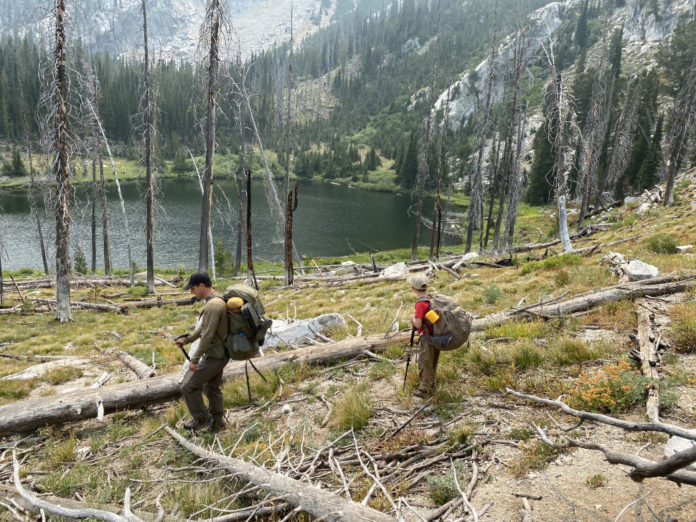When you look back on some of your fondest memories throughout your childhood, what activities and experiences stand out? Did they involve being outdoors or going to a special place?
We are fortunate to live in a state that provides many outdoor experiences, creating those lifelong family memories and traditions. Alpine lakes provide families with endless opportunities in Idaho’s scenic backcountry from fishing to wildlife watching to off-the-grid relaxation.
Alpine lake season runs from late June to late October, depending on weather conditions and snow melt. You can choose your own adventure based on how far you want to drive or hike, if you plan to do a short day hike or backpack in for a longer stay, or skip the hike and access a lake by vehicle.
Ready for an adventure? Here are some tips and resources to help you plan a family trip to an alpine lake.
Choosing the right lake
The Idaho Fish and Game Fishing Planner is your best resource for planning a trip, especially if you plan to fish. It lists over 2,000 lakes that you can filter by name, county or region, and size. Once you select a lake, you can access information about location, species observed in surveys by fisheries biologists, and fish stocking history.
When deciding on a lake, make sure it’s the right fit for your family. If you have a crew of novice hikers, start small and continue to do research on hiking distance, terrain, trail information and closures, and elevation gain.
What to pack
Whether it’s a short day hike or a backpacking trip, it’s all about packing light. With younger kids, have them carry in a small pack with basic items like water, food, clothes, utensils, and lightweight gear.
If you’re planning to camp, make sure you have all of the gear you need during your stay. Remember, what you pack in will be on your back the entire trip, so packing light is extremely important. Here is a list of lightweight items to add to your pack:
|
|
Fishing tackle: What to bring
Most alpine lakes have hungry fish just waiting to take your fly or lure, which makes for some unforgettable fishing opportunities. If the water is clear, kids can cast near the fish and watch it react (or not react, which is frustrating for any angler).
Each alpine lake is different; some are surrounded by trees while others have a mix of trees and talus slopes or grassy openings between the trees. Whether you decide to bring spinning gear or fly rod, make sure you bring ones that break down into sections for easy packing.
Spinning tackle: Most youngsters will do best with spinning tackle so they don’t have to worry about what’s behind them when they cast. Bring a small assortment of spoons and spinners, and maybe a few different types of baits (or catch grasshoppers if available).
Fly fishing: Fly anglers can be limited to certain areas of the lake because of the lake’s surroundings, but sometimes a good roll cast will get you to some of those hard-to-get spots. Bring a small fly box with woolly buggers, small nymphs, or attractor flies.
Be on the lookout for wildlife
Alpine lakes also provide opportunities to explore and watch for wildlife.
When you first arrive at a lake, pause for a second and listen for a “Bee-Jee.” The American pika is a lake favorite and can be found scurrying around boulder-covered rock slide areas near the lake.
Deer and elk usually keep their distance, but it’s not uncommon to see tracks or droppings. If you’re camping, don’t be surprised if you hear cautious steps walk through your campsite at night as an animal passes by to drink from the lake. Also, be sure to look up and listen for a variety of birds, and if you hear rocks crackling in high mountain ledges above the lake, it could be a mountain goat.
Amphibians also make their home at alpine lakes. Walk along the lakeshore to see if you can spot Western toads scurrying through willows or in the water, or search for long-toed salamanders burrowed under logs and rocks.
Other fun ideas
After a long hike, what’s more refreshing than taking a dip in the lake. For those with youngsters watch for submerged debris and rocks in shallow areas.
Did you know your sleeping pad can be used as a lake float?
Find fun snacks and meals that your family will look forward to on these trips. If you’re packing dehydrated meals, take the kids to the store with you and have them pick out their own. Pack a Jiffy Pop popcorn pan for a nice after-dinner treat as you watch incredible sunset views (use a portable camp stove and not a campfire).
Bring flavored hard candies to suck on during the hike. Ask your kids what their favorite flavors are when hiking motivation starts to dwindle, it will buy you a few more steps on the trail.
Lastly, let your kids explore and connect with nature. This is where sticks are turned into swords, a rock-skipping champion is declared, and new discoveries are made. Let their imaginations run wild!
Capture those moments
Idaho provides many opportunities to explore higher elevations and what better way to bring the family together in one of the most scenic settings.
Don’t forget to bring a camera so you can look back on lakes you visited over the years and talk about how each adventure was unique.
Happy adventures!
Looking to explore Idaho’s alpine lakes? Find information on where to fish, fishing basics, science and management, and more.
Credit: Source link































